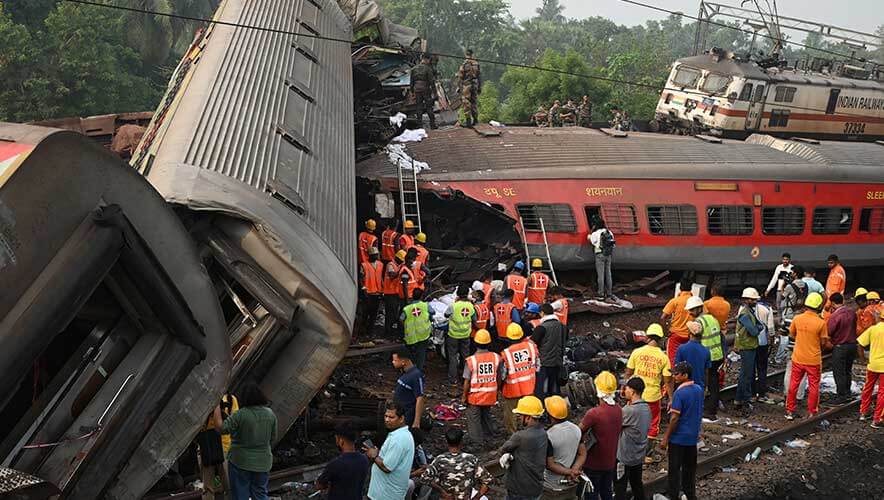India Launches In-Depth Investigation into Deadly Train Collision
At least 275 people are dead and nearly 1,200 injured following a major three-train collision in eastern India on 2 June. The derailment was caused by an error in the electronic signaling system, investigators said.
The high-speed Coromandel Express received a signal to run on the main track line, but the signal changed shortly thereafter, shifting the train over to an adjacent loop line where a freight train loaded with iron ore was parked. That initial collision flipped the express train’s coaches onto another track, derailing the oncoming Yesvantpur-Howrah Express, the Associated Press reported. Neither train was overspeeding, but both were high-speed passenger trains running at or near 80 miles per hour. The two passenger trains were carrying 2,296 people between them.
Some train carriages were stacked on top of each other, and rescue workers and other passengers rushed to get injured people out of the crumpled compartments, according to CNN. The initial death toll of 288 was revised down to 275 after a recount—amid the devastation, rescuers had counted some bodies twice.
India has invested heavily in modernizing its rail infrastructure and safety during recent years, and nearly 22 million passengers rely on the nation’s railway system every day. The electronic interlocking system in question is part of that investment. When working properly, the safety mechanism helps prevent conflicting movements between trains and monitors signal statuses to tell conductors how close they are to the next strain, how fast they can go, and the presence of any stationary trains on the track, according to the AP.
Senior railway official Jaya Verma Sinha said, “The system is 99.9 percent error free. But 0.1 percent chances are always there for an error.”
Investigators have not ruled out any other interference, including potential sabotage, she told reporters. Investigators are also seeking to uncover if the error was human or technical. India’s Railway Board has recommended that the investigation be headed by the country’s Central Bureau of Investigations—which probes major criminal cases, France24 reported.
In a visit to the crash site on 3 June, Prime Minister Narendra Modi said “no one responsible” for the crash would be spared. Railway officials and witnesses gathered in Kharagpur to start submitting evidence to the inquiry.
What caused the India train crash? A visual guide to what we know https://t.co/7gTw0aeWVK
— The Guardian (@guardian) June 4, 2023
As of 4 June, rescue and recovery efforts had concluded, and nearby hospitals were flooded with injured survivors and the families of train passengers who were desperate for news of their loved ones. Medical centers have been overwhelmed by the number of critical casualties, and authorities fear the death toll could climb even higher, according to Al Jazeera. Expert doctors, specialized equipment, and medication have been flown in from New Delhi to help.
The tracks have largely been cleared and repaired at the crash site, and train service resumed running over that section of the line by late 4 June. A special train service ran yesterday to transport survivors and dead bodies out of Odisha, and it will stop at all major stations along the line to Chennai to bring people home.
Derailments have been on the decline in the country in recent years, although they remain the most common form of rail accidents in India, the AP reported. Multiple factors cited by a 2022 report from the National Crime Records Bureau included track defects, maintenance issues, outdated signaling equipment, and human errors as the main cases of derailments. Train-on-train collisions are far less common.
Interested in learning more about rail and other transportation accident investigations? Read Security Management’s interview with the deputy managing director for investigations at the U.S. National Transportation Safety Board.










